I need a lot of help with my join statement, as it multiplies the rows of the two tables that I'm trying to join:
My Sample data:
SAPId CompendiumId Seats
----- ------------ -----
1 443 21
2 443 22
3 443 23
4 443 24
5 443 25
6 571 25
7 352 20
QBId CompendiumId Slots
----- ------------ -----
1 443 26
2 443 27
3 571 25
4 571 23
My desired output is:
CompendiumId Seats Slots
------------ ----- -----
443 115 53
571 25 48
352 20 0
but the result of my code is:
CompendiumId Seats Slots
------------ ----- -----
443 230 265
571 50 48
I think what happens here is this, where the cells highlighted with red are the ones that get duplicated:
Here is my code:
Controller
private MyContext db = new MyContext();
public ActionResult Index()
{
var sapsummarylist = (from cmp in db.Compendia
join sp in db.SAPs on cmp.Id equals sp.CompendiumId
join qb in db.QualificationBatches on cmp.Id equals qb.CompendiumId
group new { cmp.Id, sp.Seats, qb.Slots } by new { cmp.Id } into mgrp
from grp in mgrp.DefaultIfEmpty()
select new SAPSummaryViewModel
{
Id = grp.Id,
Seats = mgrp.Sum(x => x.Seats),
Slots = mgrp.Sum(x => x.Slots)
});
return View(sapsummarylist.Distinct());
}
Models
public class Compendium
{
public int Id { get; set; }
public string Name { get; set; }
public virtual ICollection<QualificationBatch> QualificationBatches { get; set; }
public virtual ICollection<SAP> SAPs { get; set; }
}
public class QualificationBatch
{
public int Id { get; set; }
public int CompendiumId { get; set; }
public int Slots { get; set; }
public virtual Compendium Compendium { get; set; }
}
public class SAP
{
public int Id { get; set; }
public int CompendiumId { get; set; }
public int Seats { get; set; }
public virtual Compendium Compendium { get; set; }
}
ViewModel
public class SAPSummaryViewModel
{
public int Id { get; set; } //Compendium
public int Slots { get; set; } //QualificationBatch
public int Seats { get; set; } //SAP
}
